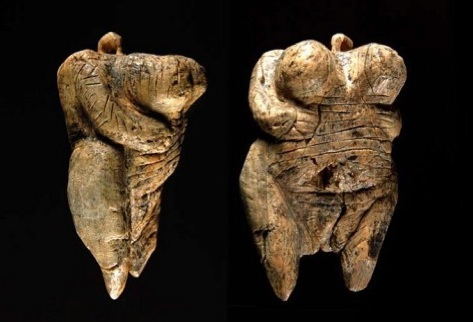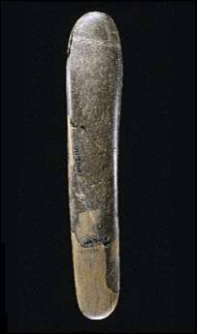Oldest Example of Figurative Art
The press is abuzz today about the aurignacian statuette (6 cm in height) discovered by archeologist Nicholas J. Conard in the “Hohle Fels” dig in the Swabian Alps and dated to between 30 & 40.000 years ago. Most comments refer to her bashfully as the oldest “fertility symbol,” thus sanitizing the statue’s strong sexual and erotic implications, though Conard is quoted in the New York Times as saying the “Venus” could be “seen as bordering on the pornographic.” The article in AlphaGalileo suggests that “this discovery radically changes our views of the context and meaning of the earliest Paleolithic art,” as it “refutes claims that figurative representations and other symbolic artifacts first appear the later phases of the Swabian Aurignacian,” and goes on to say:
The Venus shows a range of entirely unique features as well as a number of characteristics present in later female figurines. The Venus of Hohle Fels lacks a head. Instead an off-centered, but carefully carved ring is located above the broad shoulders of the figurine. This ring, despite being weathered, preserves polish suggesting that the figurine was worn as a pendant. Beneath the shoulders, which are roughly as thick as they are wide, large breasts project forward. The figurine has two short arms with two carefully carved hands with visible fingers resting on the upper part of the stomach below the breasts.
The Venus has a short and squat form with a waist that is slightly narrower than the broad shoulders and wide hips. Multiple deeply incised horizontal lines cover the abdomen from the area below the breast to the pubic triangle. Several of these horizontal lines extend to the back of the figurine and are suggestive of clothing or a wrap of some sort. Microscopic images show that these incisions were created by repeatedly cutting along the same lines with sharp stone tools.
The legs of the Venus are short and pointy. The buttocks and genitals are depicted in more details. The split between the two halves of the buttocks is deep and continues without interruption to the front of the figurine where the vulva is visible between the open legs. There can be no doubt that the depiction of oversized breast, exentuated buttocks and genetalia result from the deliberate exaggeration of the sexual features of the figurine. In addition to the many carefully depicted anatomical features, the surface of the Venus preserves numerous lines and deliberate markings.
Many of the features, including the emphasis on sexual attributes and lack of emphasis on the head, face and arms and legs, call to mind aspects of the numerous Venus figurines well known from the European Gravettien, which typically date between 22 and 27 ka BP. The careful depiction of the hands is reminiscent of those of Venuses including that of archetypal Venus of Willendorf, which was discovered 100 years earlier in summer of 1908. Despite the far greater age of the Venus of Hohle Fels, many of its attributes occur in various forms throughout the rich tradition of Paleolithic female representations.
The new figurine from Hohle Fels radically changes our view of origins of Paleolithic art. Prior to this discovery, animals and therianthropic imagry dominated the over two dozen figurines from the Swabian Aurignacian. Female imagry was entirely unknown. With this discovery, the notion that three dimensional female imagry developed in the Gravettian can be rejected. Also the interpretations suggesting that strong, aggressive animals or shamanic depictions dominate the Aurignacian art of Swabia, or even Europe as a whole, need to be reconsidered. Although there is a long history of debate over the meaning of Paleolithic Venuses, their clear sexual attributes suggest that they are a direct or indirect expression of fertility. The Venus of Hohle Fels provides an entirely new view of the art from the early Upper Paleolithic and reinforces the arguments that have been made for innovative cultural manifestations accompanying the rise of the Swabian Aurignacian.
But beyond the “direct or indirect expression of fertility” argument it would be interesting to rethink this origin of figurative art from its vulvic space, i.e. from its sexual/erotic sources, & to suggest that the fact of human eros (an eros quite likely un- or only liminally connected to “fertility” as such) is the core source at the root of art. That the sexual was core to early man is also attested by another, admittedly later (~25000 years ago), piece of sculpture that has gotten much less press as its implications are definitively erotic (the scientists are in agreement that this piece was used as a “sex aid” while also being misused to chip flint ):



 Poasis II: Selected Poems 2000-2024
Poasis II: Selected Poems 2000-2024 “Todesguge/Deathfugue”
“Todesguge/Deathfugue” “Interglacial Narrows (Poems 1915-2021)”
“Interglacial Narrows (Poems 1915-2021)” “Always the Many, Never the One: Conversations In-between, with Florent Toniello”
“Always the Many, Never the One: Conversations In-between, with Florent Toniello” “Conversations in the Pyrenees”
“Conversations in the Pyrenees” “A Voice Full of Cities: The Collected Essays of Robert Kelly.” Edited by Pierre Joris & Peter Cockelbergh
“A Voice Full of Cities: The Collected Essays of Robert Kelly.” Edited by Pierre Joris & Peter Cockelbergh “An American Suite” (Poems) —Inpatient Press
“An American Suite” (Poems) —Inpatient Press “Arabia (not so) Deserta” : Essays on Maghrebi & Mashreqi Writing & Culture
“Arabia (not so) Deserta” : Essays on Maghrebi & Mashreqi Writing & Culture “Barzakh” (Poems 2000-2012)
“Barzakh” (Poems 2000-2012) “Fox-trails, -tales & -trots”
“Fox-trails, -tales & -trots” “The Agony of I.B.” — A play. Editions PHI & TNL 2016
“The Agony of I.B.” — A play. Editions PHI & TNL 2016 “The Book of U / Le livre des cormorans”
“The Book of U / Le livre des cormorans” “Memory Rose Into Threshold Speech: The Collected Earlier Poetry of Paul Celan”
“Memory Rose Into Threshold Speech: The Collected Earlier Poetry of Paul Celan” “Paul Celan, Microliths They Are, Little Stones”
“Paul Celan, Microliths They Are, Little Stones” “Paul Celan: Breathturn into Timestead-The Collected Later Poetry.” Translated & with commentary by Pierre Joris. Farrar, Straus & Giroux
“Paul Celan: Breathturn into Timestead-The Collected Later Poetry.” Translated & with commentary by Pierre Joris. Farrar, Straus & Giroux
What a beautiful prehistoric female figurine sculpture I have ever seen. She is very unique compare with other female figurines we have found around the world.